An Analysis of Performance Related Pay in Employee Motivation
VerifiedAdded on 2019/12/03
|12
|3739
|22
Report
AI Summary
This report analyzes the significance of performance-related pay in motivating employees, examining its impact on productivity and efficiency. The research explores the effectiveness of financial incentives, considering both positive and negative aspects, and aims to understand how performance-rela...
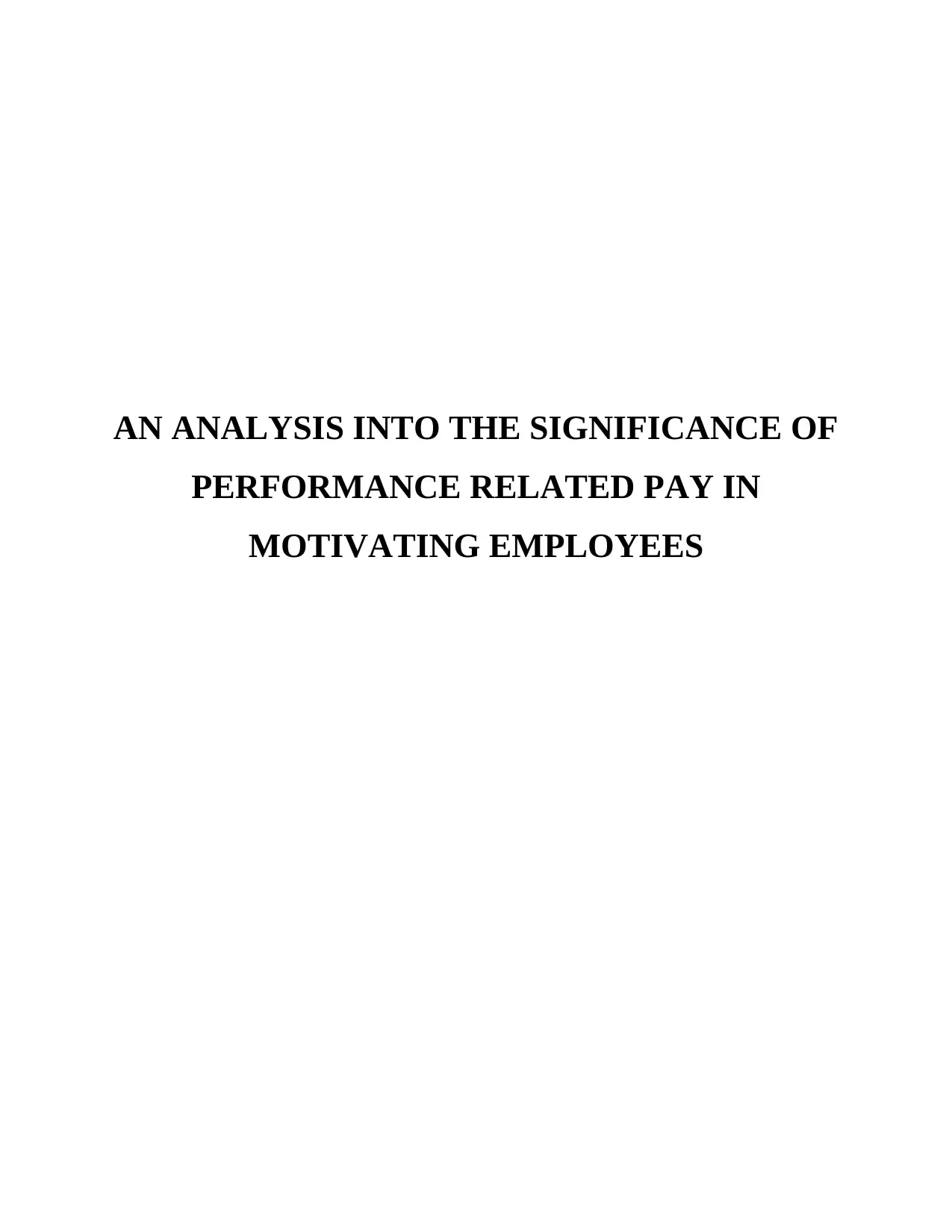
AN ANALYSIS INTO THE SIGNIFICANCE OF
PERFORMANCE RELATED PAY IN
MOTIVATING EMPLOYEES
PERFORMANCE RELATED PAY IN
MOTIVATING EMPLOYEES
Secure Best Marks with AI Grader
Need help grading? Try our AI Grader for instant feedback on your assignments.
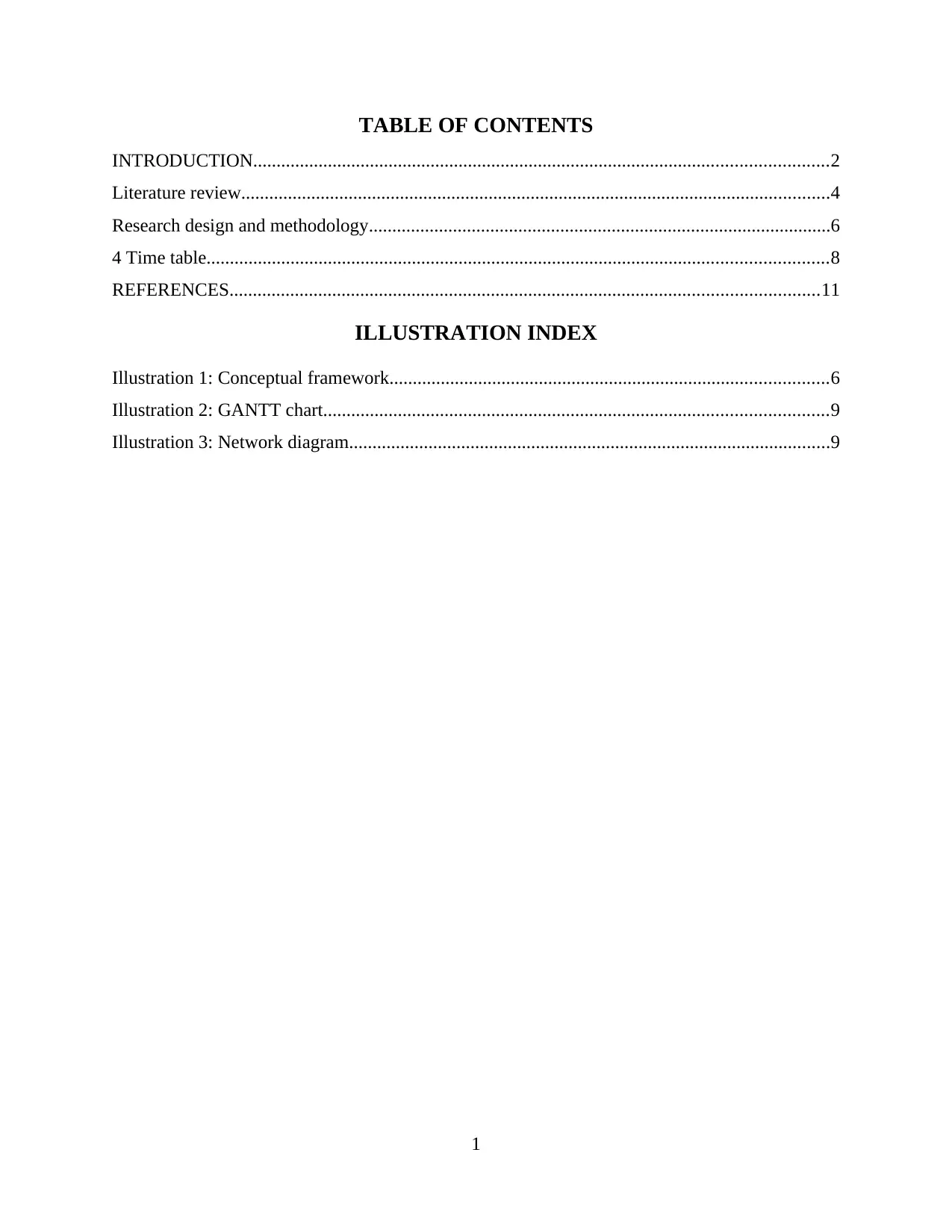
TABLE OF CONTENTS
INTRODUCTION...........................................................................................................................2
Literature review..............................................................................................................................4
Research design and methodology...................................................................................................6
4 Time table.....................................................................................................................................8
REFERENCES..............................................................................................................................11
ILLUSTRATION INDEX
Illustration 1: Conceptual framework..............................................................................................6
Illustration 2: GANTT chart............................................................................................................9
Illustration 3: Network diagram.......................................................................................................9
1
INTRODUCTION...........................................................................................................................2
Literature review..............................................................................................................................4
Research design and methodology...................................................................................................6
4 Time table.....................................................................................................................................8
REFERENCES..............................................................................................................................11
ILLUSTRATION INDEX
Illustration 1: Conceptual framework..............................................................................................6
Illustration 2: GANTT chart............................................................................................................9
Illustration 3: Network diagram.......................................................................................................9
1
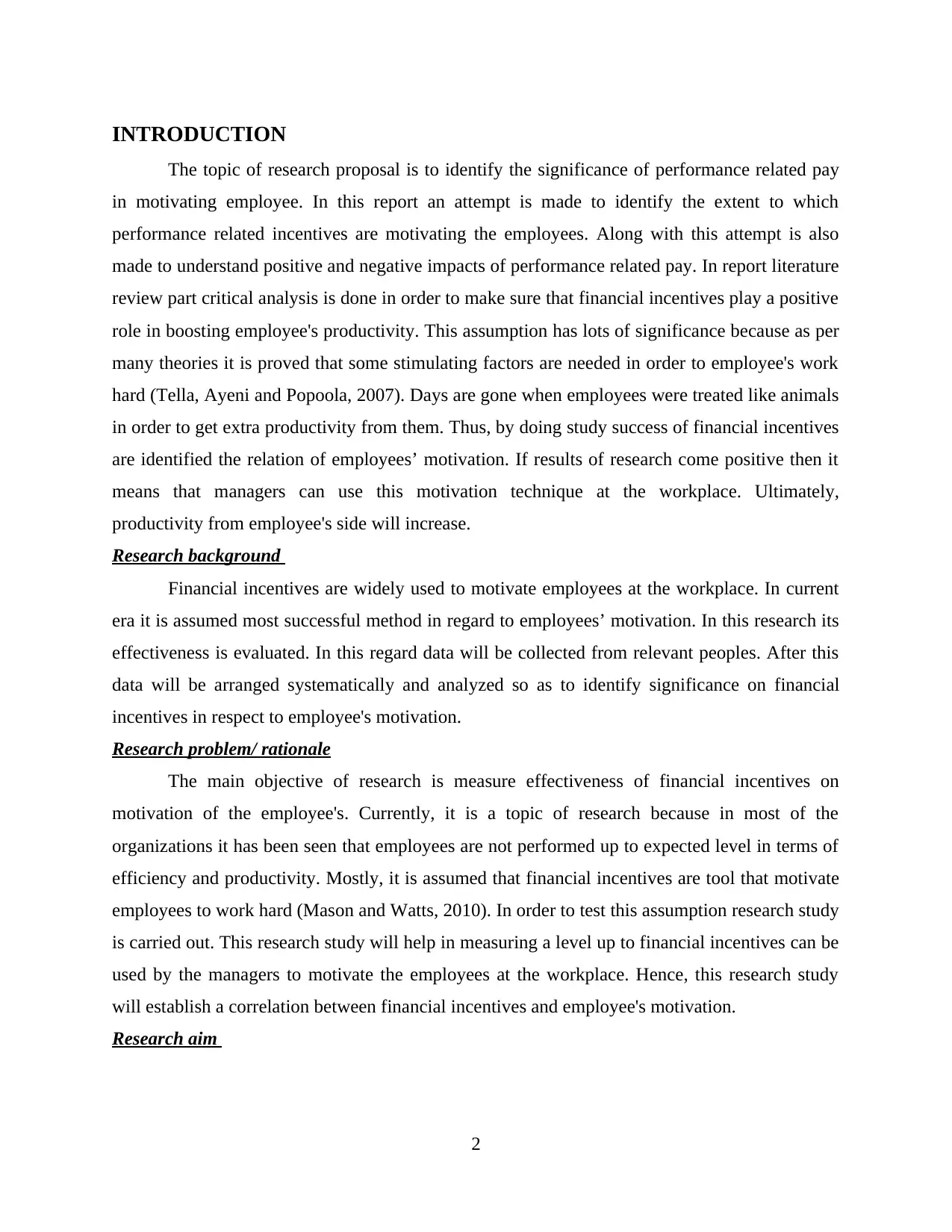
INTRODUCTION
The topic of research proposal is to identify the significance of performance related pay
in motivating employee. In this report an attempt is made to identify the extent to which
performance related incentives are motivating the employees. Along with this attempt is also
made to understand positive and negative impacts of performance related pay. In report literature
review part critical analysis is done in order to make sure that financial incentives play a positive
role in boosting employee's productivity. This assumption has lots of significance because as per
many theories it is proved that some stimulating factors are needed in order to employee's work
hard (Tella, Ayeni and Popoola, 2007). Days are gone when employees were treated like animals
in order to get extra productivity from them. Thus, by doing study success of financial incentives
are identified the relation of employees’ motivation. If results of research come positive then it
means that managers can use this motivation technique at the workplace. Ultimately,
productivity from employee's side will increase.
Research background
Financial incentives are widely used to motivate employees at the workplace. In current
era it is assumed most successful method in regard to employees’ motivation. In this research its
effectiveness is evaluated. In this regard data will be collected from relevant peoples. After this
data will be arranged systematically and analyzed so as to identify significance on financial
incentives in respect to employee's motivation.
Research problem/ rationale
The main objective of research is measure effectiveness of financial incentives on
motivation of the employee's. Currently, it is a topic of research because in most of the
organizations it has been seen that employees are not performed up to expected level in terms of
efficiency and productivity. Mostly, it is assumed that financial incentives are tool that motivate
employees to work hard (Mason and Watts, 2010). In order to test this assumption research study
is carried out. This research study will help in measuring a level up to financial incentives can be
used by the managers to motivate the employees at the workplace. Hence, this research study
will establish a correlation between financial incentives and employee's motivation.
Research aim
2
The topic of research proposal is to identify the significance of performance related pay
in motivating employee. In this report an attempt is made to identify the extent to which
performance related incentives are motivating the employees. Along with this attempt is also
made to understand positive and negative impacts of performance related pay. In report literature
review part critical analysis is done in order to make sure that financial incentives play a positive
role in boosting employee's productivity. This assumption has lots of significance because as per
many theories it is proved that some stimulating factors are needed in order to employee's work
hard (Tella, Ayeni and Popoola, 2007). Days are gone when employees were treated like animals
in order to get extra productivity from them. Thus, by doing study success of financial incentives
are identified the relation of employees’ motivation. If results of research come positive then it
means that managers can use this motivation technique at the workplace. Ultimately,
productivity from employee's side will increase.
Research background
Financial incentives are widely used to motivate employees at the workplace. In current
era it is assumed most successful method in regard to employees’ motivation. In this research its
effectiveness is evaluated. In this regard data will be collected from relevant peoples. After this
data will be arranged systematically and analyzed so as to identify significance on financial
incentives in respect to employee's motivation.
Research problem/ rationale
The main objective of research is measure effectiveness of financial incentives on
motivation of the employee's. Currently, it is a topic of research because in most of the
organizations it has been seen that employees are not performed up to expected level in terms of
efficiency and productivity. Mostly, it is assumed that financial incentives are tool that motivate
employees to work hard (Mason and Watts, 2010). In order to test this assumption research study
is carried out. This research study will help in measuring a level up to financial incentives can be
used by the managers to motivate the employees at the workplace. Hence, this research study
will establish a correlation between financial incentives and employee's motivation.
Research aim
2
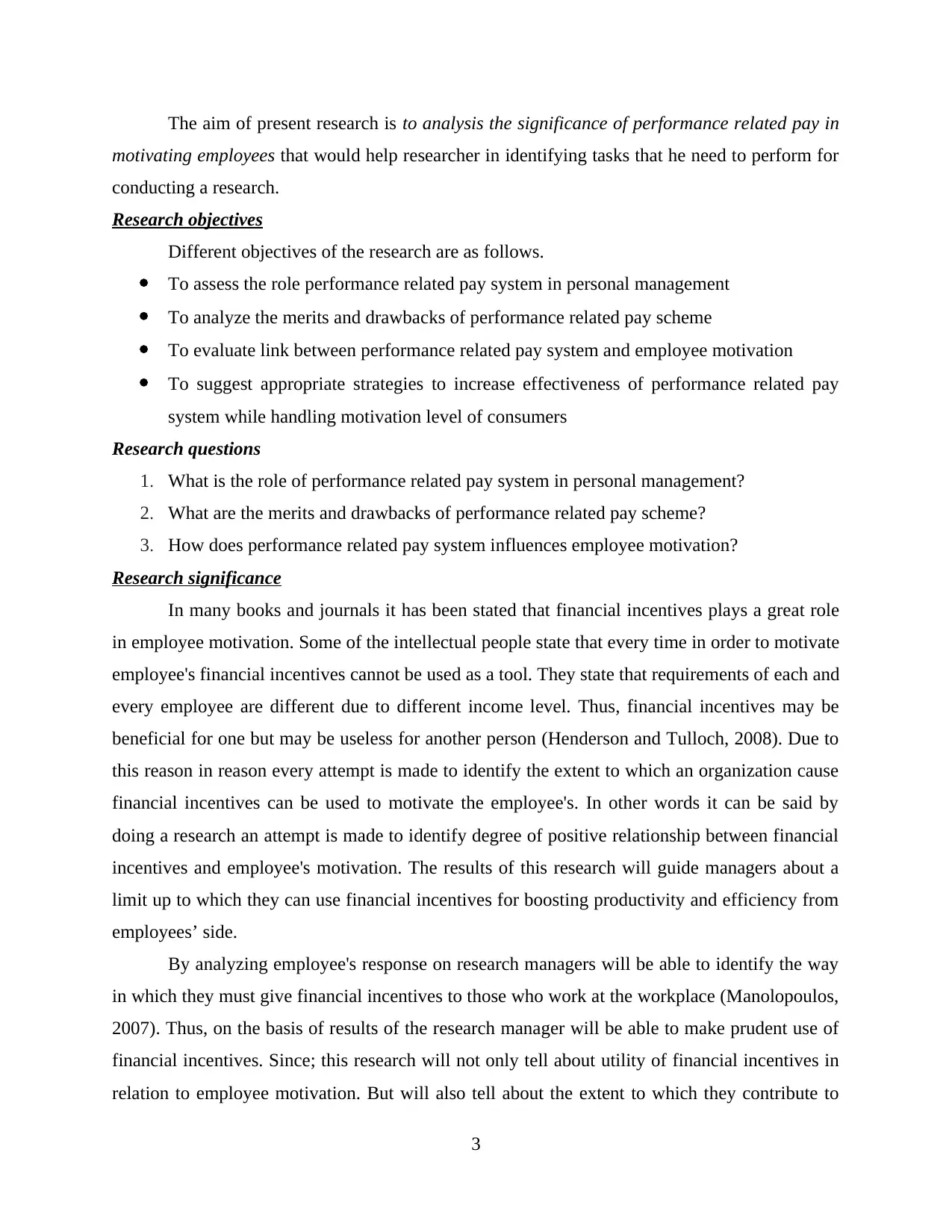
The aim of present research is to analysis the significance of performance related pay in
motivating employees that would help researcher in identifying tasks that he need to perform for
conducting a research.
Research objectives
Different objectives of the research are as follows.
To assess the role performance related pay system in personal management
To analyze the merits and drawbacks of performance related pay scheme
To evaluate link between performance related pay system and employee motivation
To suggest appropriate strategies to increase effectiveness of performance related pay
system while handling motivation level of consumers
Research questions
1. What is the role of performance related pay system in personal management?
2. What are the merits and drawbacks of performance related pay scheme?
3. How does performance related pay system influences employee motivation?
Research significance
In many books and journals it has been stated that financial incentives plays a great role
in employee motivation. Some of the intellectual people state that every time in order to motivate
employee's financial incentives cannot be used as a tool. They state that requirements of each and
every employee are different due to different income level. Thus, financial incentives may be
beneficial for one but may be useless for another person (Henderson and Tulloch, 2008). Due to
this reason in reason every attempt is made to identify the extent to which an organization cause
financial incentives can be used to motivate the employee's. In other words it can be said by
doing a research an attempt is made to identify degree of positive relationship between financial
incentives and employee's motivation. The results of this research will guide managers about a
limit up to which they can use financial incentives for boosting productivity and efficiency from
employees’ side.
By analyzing employee's response on research managers will be able to identify the way
in which they must give financial incentives to those who work at the workplace (Manolopoulos,
2007). Thus, on the basis of results of the research manager will be able to make prudent use of
financial incentives. Since; this research will not only tell about utility of financial incentives in
relation to employee motivation. But will also tell about the extent to which they contribute to
3
motivating employees that would help researcher in identifying tasks that he need to perform for
conducting a research.
Research objectives
Different objectives of the research are as follows.
To assess the role performance related pay system in personal management
To analyze the merits and drawbacks of performance related pay scheme
To evaluate link between performance related pay system and employee motivation
To suggest appropriate strategies to increase effectiveness of performance related pay
system while handling motivation level of consumers
Research questions
1. What is the role of performance related pay system in personal management?
2. What are the merits and drawbacks of performance related pay scheme?
3. How does performance related pay system influences employee motivation?
Research significance
In many books and journals it has been stated that financial incentives plays a great role
in employee motivation. Some of the intellectual people state that every time in order to motivate
employee's financial incentives cannot be used as a tool. They state that requirements of each and
every employee are different due to different income level. Thus, financial incentives may be
beneficial for one but may be useless for another person (Henderson and Tulloch, 2008). Due to
this reason in reason every attempt is made to identify the extent to which an organization cause
financial incentives can be used to motivate the employee's. In other words it can be said by
doing a research an attempt is made to identify degree of positive relationship between financial
incentives and employee's motivation. The results of this research will guide managers about a
limit up to which they can use financial incentives for boosting productivity and efficiency from
employees’ side.
By analyzing employee's response on research managers will be able to identify the way
in which they must give financial incentives to those who work at the workplace (Manolopoulos,
2007). Thus, on the basis of results of the research manager will be able to make prudent use of
financial incentives. Since; this research will not only tell about utility of financial incentives in
relation to employee motivation. But will also tell about the extent to which they contribute to
3
Secure Best Marks with AI Grader
Need help grading? Try our AI Grader for instant feedback on your assignments.
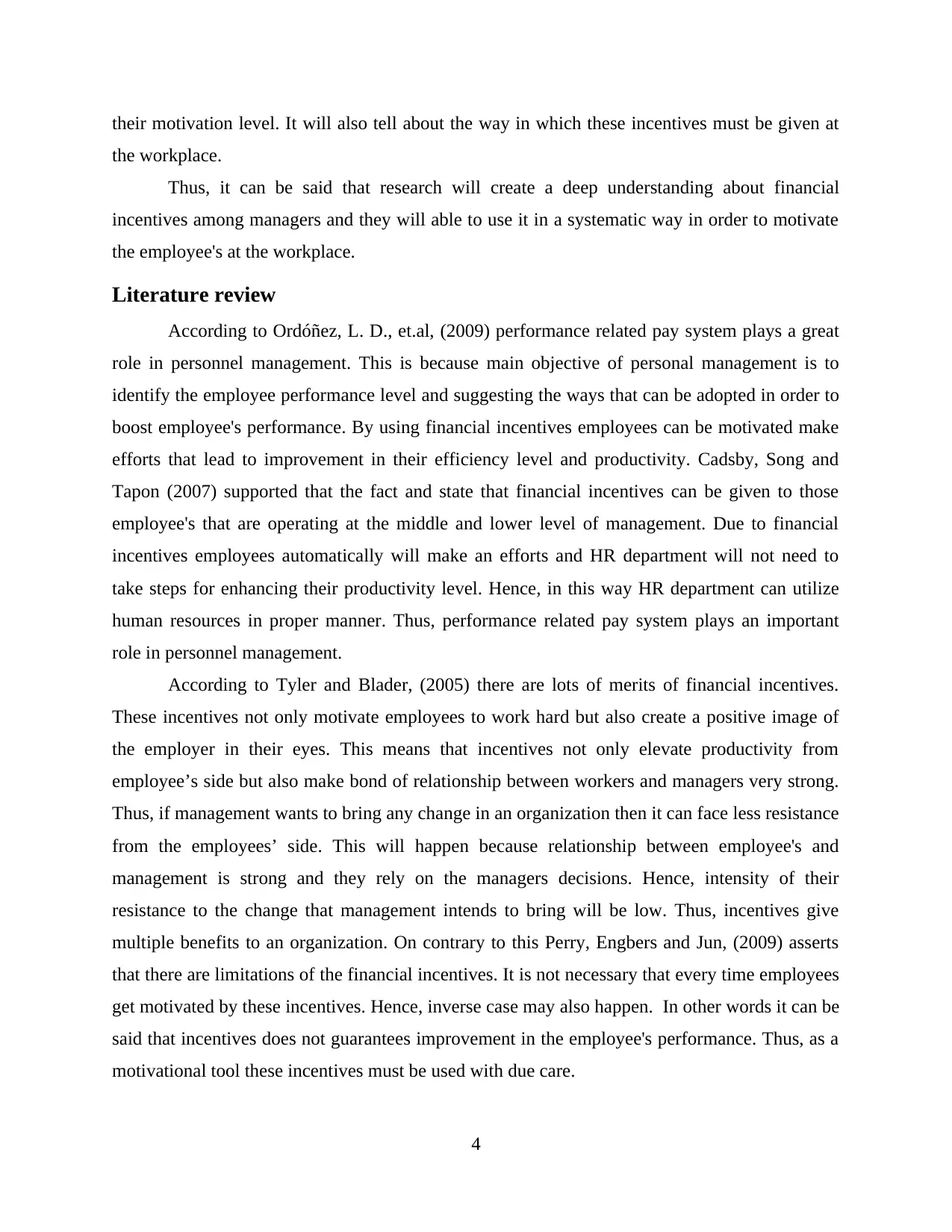
their motivation level. It will also tell about the way in which these incentives must be given at
the workplace.
Thus, it can be said that research will create a deep understanding about financial
incentives among managers and they will able to use it in a systematic way in order to motivate
the employee's at the workplace.
Literature review
According to Ordóñez, L. D., et.al, (2009) performance related pay system plays a great
role in personnel management. This is because main objective of personal management is to
identify the employee performance level and suggesting the ways that can be adopted in order to
boost employee's performance. By using financial incentives employees can be motivated make
efforts that lead to improvement in their efficiency level and productivity. Cadsby, Song and
Tapon (2007) supported that the fact and state that financial incentives can be given to those
employee's that are operating at the middle and lower level of management. Due to financial
incentives employees automatically will make an efforts and HR department will not need to
take steps for enhancing their productivity level. Hence, in this way HR department can utilize
human resources in proper manner. Thus, performance related pay system plays an important
role in personnel management.
According to Tyler and Blader, (2005) there are lots of merits of financial incentives.
These incentives not only motivate employees to work hard but also create a positive image of
the employer in their eyes. This means that incentives not only elevate productivity from
employee’s side but also make bond of relationship between workers and managers very strong.
Thus, if management wants to bring any change in an organization then it can face less resistance
from the employees’ side. This will happen because relationship between employee's and
management is strong and they rely on the managers decisions. Hence, intensity of their
resistance to the change that management intends to bring will be low. Thus, incentives give
multiple benefits to an organization. On contrary to this Perry, Engbers and Jun, (2009) asserts
that there are limitations of the financial incentives. It is not necessary that every time employees
get motivated by these incentives. Hence, inverse case may also happen. In other words it can be
said that incentives does not guarantees improvement in the employee's performance. Thus, as a
motivational tool these incentives must be used with due care.
4
the workplace.
Thus, it can be said that research will create a deep understanding about financial
incentives among managers and they will able to use it in a systematic way in order to motivate
the employee's at the workplace.
Literature review
According to Ordóñez, L. D., et.al, (2009) performance related pay system plays a great
role in personnel management. This is because main objective of personal management is to
identify the employee performance level and suggesting the ways that can be adopted in order to
boost employee's performance. By using financial incentives employees can be motivated make
efforts that lead to improvement in their efficiency level and productivity. Cadsby, Song and
Tapon (2007) supported that the fact and state that financial incentives can be given to those
employee's that are operating at the middle and lower level of management. Due to financial
incentives employees automatically will make an efforts and HR department will not need to
take steps for enhancing their productivity level. Hence, in this way HR department can utilize
human resources in proper manner. Thus, performance related pay system plays an important
role in personnel management.
According to Tyler and Blader, (2005) there are lots of merits of financial incentives.
These incentives not only motivate employees to work hard but also create a positive image of
the employer in their eyes. This means that incentives not only elevate productivity from
employee’s side but also make bond of relationship between workers and managers very strong.
Thus, if management wants to bring any change in an organization then it can face less resistance
from the employees’ side. This will happen because relationship between employee's and
management is strong and they rely on the managers decisions. Hence, intensity of their
resistance to the change that management intends to bring will be low. Thus, incentives give
multiple benefits to an organization. On contrary to this Perry, Engbers and Jun, (2009) asserts
that there are limitations of the financial incentives. It is not necessary that every time employees
get motivated by these incentives. Hence, inverse case may also happen. In other words it can be
said that incentives does not guarantees improvement in the employee's performance. Thus, as a
motivational tool these incentives must be used with due care.
4
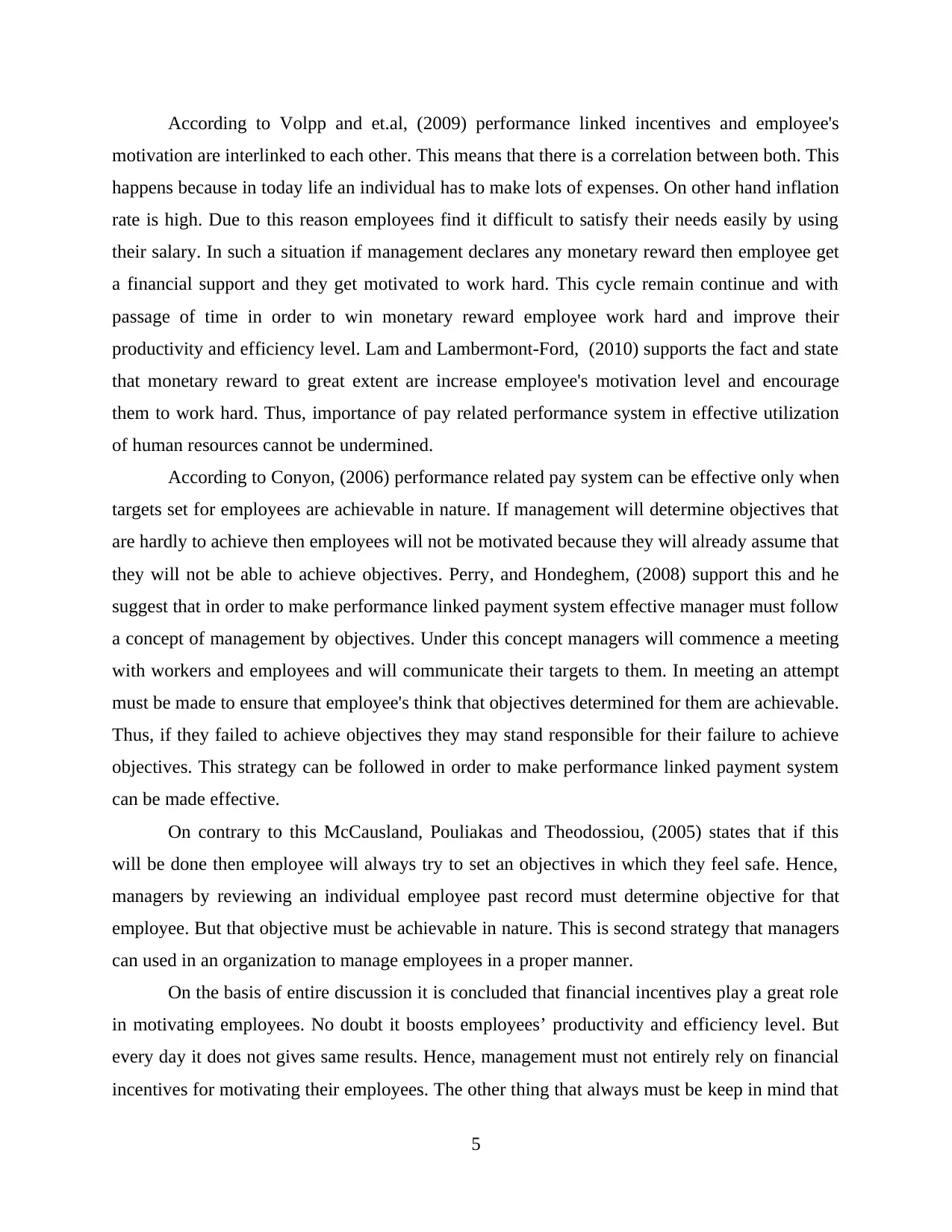
According to Volpp and et.al, (2009) performance linked incentives and employee's
motivation are interlinked to each other. This means that there is a correlation between both. This
happens because in today life an individual has to make lots of expenses. On other hand inflation
rate is high. Due to this reason employees find it difficult to satisfy their needs easily by using
their salary. In such a situation if management declares any monetary reward then employee get
a financial support and they get motivated to work hard. This cycle remain continue and with
passage of time in order to win monetary reward employee work hard and improve their
productivity and efficiency level. Lam and Lambermont-Ford, (2010) supports the fact and state
that monetary reward to great extent are increase employee's motivation level and encourage
them to work hard. Thus, importance of pay related performance system in effective utilization
of human resources cannot be undermined.
According to Conyon, (2006) performance related pay system can be effective only when
targets set for employees are achievable in nature. If management will determine objectives that
are hardly to achieve then employees will not be motivated because they will already assume that
they will not be able to achieve objectives. Perry, and Hondeghem, (2008) support this and he
suggest that in order to make performance linked payment system effective manager must follow
a concept of management by objectives. Under this concept managers will commence a meeting
with workers and employees and will communicate their targets to them. In meeting an attempt
must be made to ensure that employee's think that objectives determined for them are achievable.
Thus, if they failed to achieve objectives they may stand responsible for their failure to achieve
objectives. This strategy can be followed in order to make performance linked payment system
can be made effective.
On contrary to this McCausland, Pouliakas and Theodossiou, (2005) states that if this
will be done then employee will always try to set an objectives in which they feel safe. Hence,
managers by reviewing an individual employee past record must determine objective for that
employee. But that objective must be achievable in nature. This is second strategy that managers
can used in an organization to manage employees in a proper manner.
On the basis of entire discussion it is concluded that financial incentives play a great role
in motivating employees. No doubt it boosts employees’ productivity and efficiency level. But
every day it does not gives same results. Hence, management must not entirely rely on financial
incentives for motivating their employees. The other thing that always must be keep in mind that
5
motivation are interlinked to each other. This means that there is a correlation between both. This
happens because in today life an individual has to make lots of expenses. On other hand inflation
rate is high. Due to this reason employees find it difficult to satisfy their needs easily by using
their salary. In such a situation if management declares any monetary reward then employee get
a financial support and they get motivated to work hard. This cycle remain continue and with
passage of time in order to win monetary reward employee work hard and improve their
productivity and efficiency level. Lam and Lambermont-Ford, (2010) supports the fact and state
that monetary reward to great extent are increase employee's motivation level and encourage
them to work hard. Thus, importance of pay related performance system in effective utilization
of human resources cannot be undermined.
According to Conyon, (2006) performance related pay system can be effective only when
targets set for employees are achievable in nature. If management will determine objectives that
are hardly to achieve then employees will not be motivated because they will already assume that
they will not be able to achieve objectives. Perry, and Hondeghem, (2008) support this and he
suggest that in order to make performance linked payment system effective manager must follow
a concept of management by objectives. Under this concept managers will commence a meeting
with workers and employees and will communicate their targets to them. In meeting an attempt
must be made to ensure that employee's think that objectives determined for them are achievable.
Thus, if they failed to achieve objectives they may stand responsible for their failure to achieve
objectives. This strategy can be followed in order to make performance linked payment system
can be made effective.
On contrary to this McCausland, Pouliakas and Theodossiou, (2005) states that if this
will be done then employee will always try to set an objectives in which they feel safe. Hence,
managers by reviewing an individual employee past record must determine objective for that
employee. But that objective must be achievable in nature. This is second strategy that managers
can used in an organization to manage employees in a proper manner.
On the basis of entire discussion it is concluded that financial incentives play a great role
in motivating employees. No doubt it boosts employees’ productivity and efficiency level. But
every day it does not gives same results. Hence, management must not entirely rely on financial
incentives for motivating their employees. The other thing that always must be keep in mind that
5
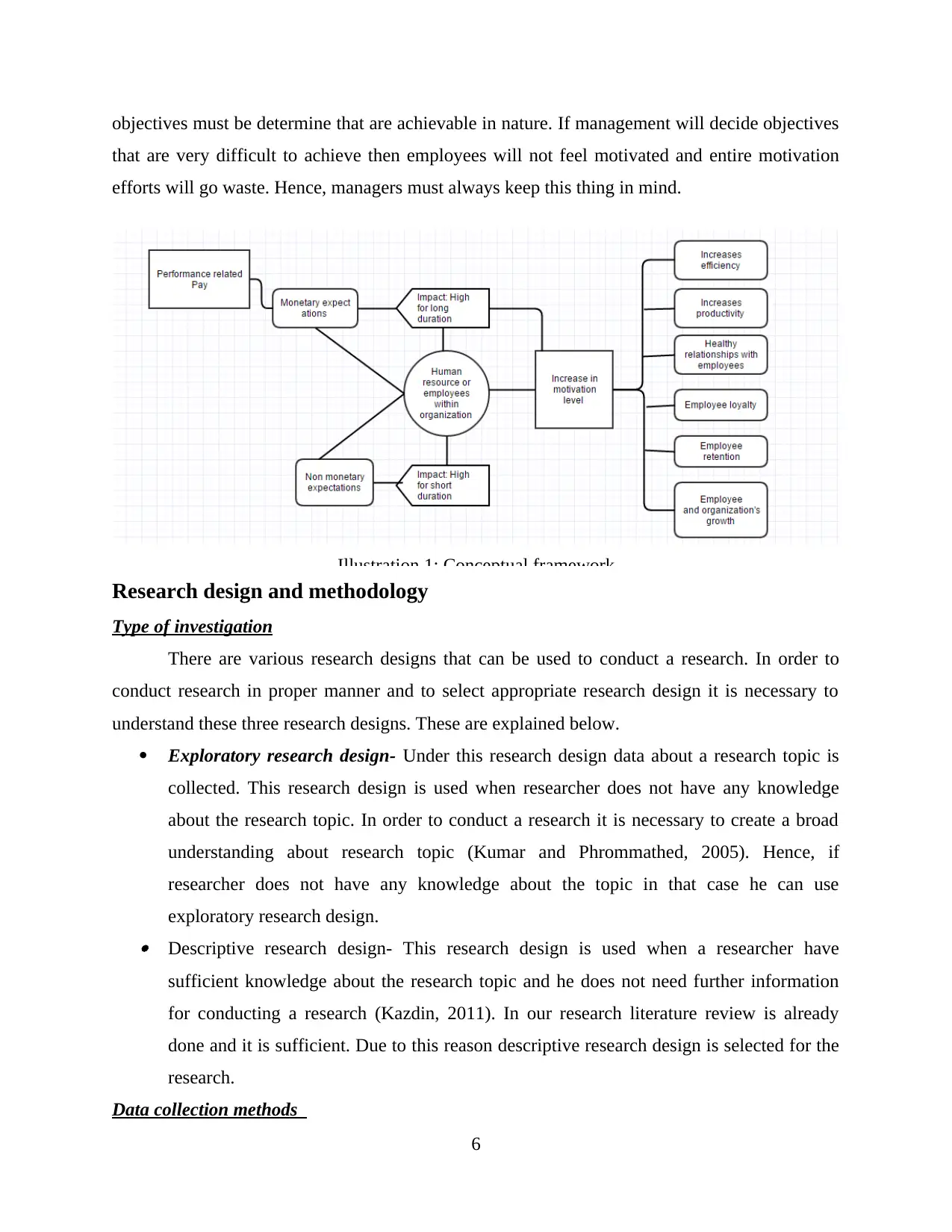
objectives must be determine that are achievable in nature. If management will decide objectives
that are very difficult to achieve then employees will not feel motivated and entire motivation
efforts will go waste. Hence, managers must always keep this thing in mind.
Research design and methodology
Type of investigation
There are various research designs that can be used to conduct a research. In order to
conduct research in proper manner and to select appropriate research design it is necessary to
understand these three research designs. These are explained below.
Exploratory research design- Under this research design data about a research topic is
collected. This research design is used when researcher does not have any knowledge
about the research topic. In order to conduct a research it is necessary to create a broad
understanding about research topic (Kumar and Phrommathed, 2005). Hence, if
researcher does not have any knowledge about the topic in that case he can use
exploratory research design. Descriptive research design- This research design is used when a researcher have
sufficient knowledge about the research topic and he does not need further information
for conducting a research (Kazdin, 2011). In our research literature review is already
done and it is sufficient. Due to this reason descriptive research design is selected for the
research.
Data collection methods
6
Illustration 1: Conceptual framework
that are very difficult to achieve then employees will not feel motivated and entire motivation
efforts will go waste. Hence, managers must always keep this thing in mind.
Research design and methodology
Type of investigation
There are various research designs that can be used to conduct a research. In order to
conduct research in proper manner and to select appropriate research design it is necessary to
understand these three research designs. These are explained below.
Exploratory research design- Under this research design data about a research topic is
collected. This research design is used when researcher does not have any knowledge
about the research topic. In order to conduct a research it is necessary to create a broad
understanding about research topic (Kumar and Phrommathed, 2005). Hence, if
researcher does not have any knowledge about the topic in that case he can use
exploratory research design. Descriptive research design- This research design is used when a researcher have
sufficient knowledge about the research topic and he does not need further information
for conducting a research (Kazdin, 2011). In our research literature review is already
done and it is sufficient. Due to this reason descriptive research design is selected for the
research.
Data collection methods
6
Illustration 1: Conceptual framework
Paraphrase This Document
Need a fresh take? Get an instant paraphrase of this document with our AI Paraphraser
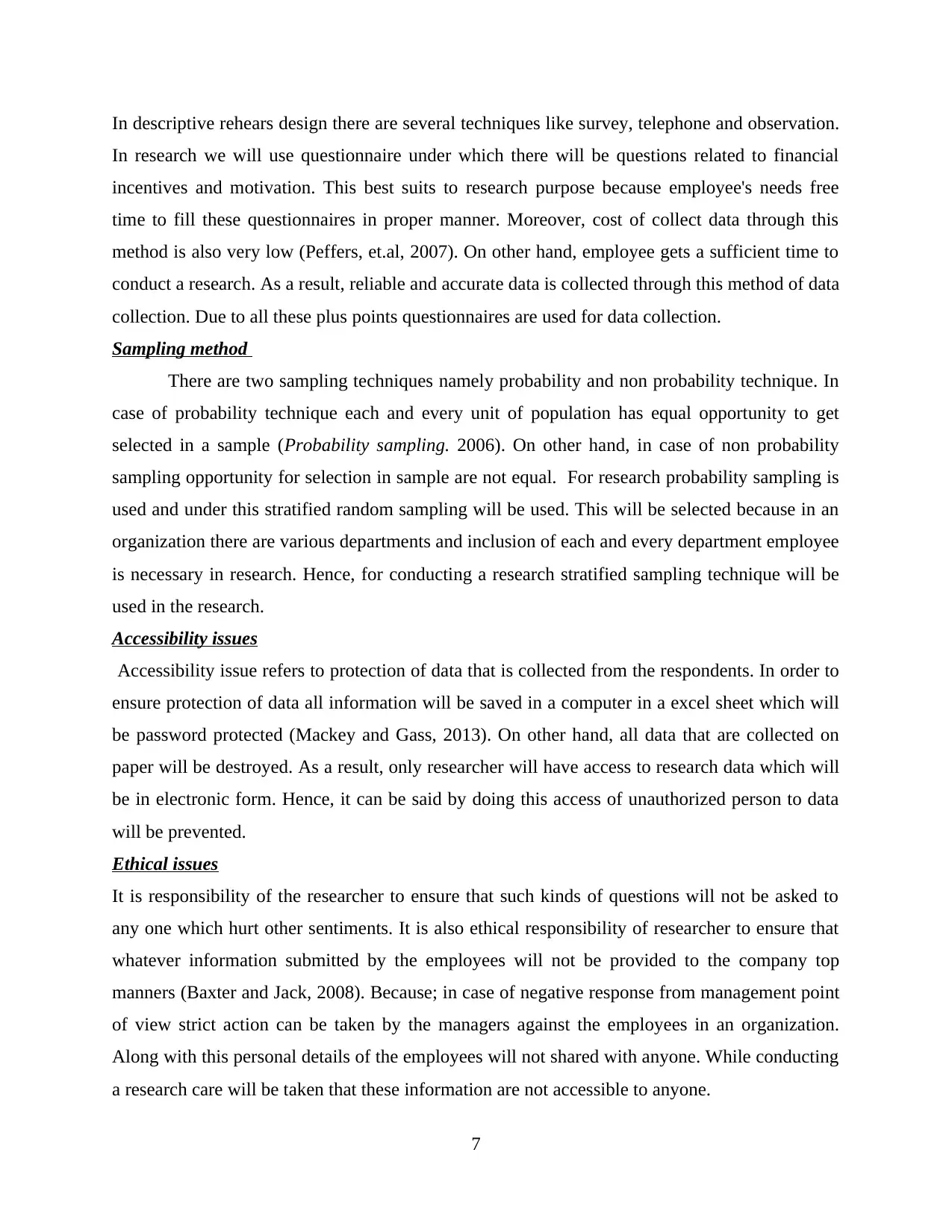
In descriptive rehears design there are several techniques like survey, telephone and observation.
In research we will use questionnaire under which there will be questions related to financial
incentives and motivation. This best suits to research purpose because employee's needs free
time to fill these questionnaires in proper manner. Moreover, cost of collect data through this
method is also very low (Peffers, et.al, 2007). On other hand, employee gets a sufficient time to
conduct a research. As a result, reliable and accurate data is collected through this method of data
collection. Due to all these plus points questionnaires are used for data collection.
Sampling method
There are two sampling techniques namely probability and non probability technique. In
case of probability technique each and every unit of population has equal opportunity to get
selected in a sample (Probability sampling. 2006). On other hand, in case of non probability
sampling opportunity for selection in sample are not equal. For research probability sampling is
used and under this stratified random sampling will be used. This will be selected because in an
organization there are various departments and inclusion of each and every department employee
is necessary in research. Hence, for conducting a research stratified sampling technique will be
used in the research.
Accessibility issues
Accessibility issue refers to protection of data that is collected from the respondents. In order to
ensure protection of data all information will be saved in a computer in a excel sheet which will
be password protected (Mackey and Gass, 2013). On other hand, all data that are collected on
paper will be destroyed. As a result, only researcher will have access to research data which will
be in electronic form. Hence, it can be said by doing this access of unauthorized person to data
will be prevented.
Ethical issues
It is responsibility of the researcher to ensure that such kinds of questions will not be asked to
any one which hurt other sentiments. It is also ethical responsibility of researcher to ensure that
whatever information submitted by the employees will not be provided to the company top
manners (Baxter and Jack, 2008). Because; in case of negative response from management point
of view strict action can be taken by the managers against the employees in an organization.
Along with this personal details of the employees will not shared with anyone. While conducting
a research care will be taken that these information are not accessible to anyone.
7
In research we will use questionnaire under which there will be questions related to financial
incentives and motivation. This best suits to research purpose because employee's needs free
time to fill these questionnaires in proper manner. Moreover, cost of collect data through this
method is also very low (Peffers, et.al, 2007). On other hand, employee gets a sufficient time to
conduct a research. As a result, reliable and accurate data is collected through this method of data
collection. Due to all these plus points questionnaires are used for data collection.
Sampling method
There are two sampling techniques namely probability and non probability technique. In
case of probability technique each and every unit of population has equal opportunity to get
selected in a sample (Probability sampling. 2006). On other hand, in case of non probability
sampling opportunity for selection in sample are not equal. For research probability sampling is
used and under this stratified random sampling will be used. This will be selected because in an
organization there are various departments and inclusion of each and every department employee
is necessary in research. Hence, for conducting a research stratified sampling technique will be
used in the research.
Accessibility issues
Accessibility issue refers to protection of data that is collected from the respondents. In order to
ensure protection of data all information will be saved in a computer in a excel sheet which will
be password protected (Mackey and Gass, 2013). On other hand, all data that are collected on
paper will be destroyed. As a result, only researcher will have access to research data which will
be in electronic form. Hence, it can be said by doing this access of unauthorized person to data
will be prevented.
Ethical issues
It is responsibility of the researcher to ensure that such kinds of questions will not be asked to
any one which hurt other sentiments. It is also ethical responsibility of researcher to ensure that
whatever information submitted by the employees will not be provided to the company top
manners (Baxter and Jack, 2008). Because; in case of negative response from management point
of view strict action can be taken by the managers against the employees in an organization.
Along with this personal details of the employees will not shared with anyone. While conducting
a research care will be taken that these information are not accessible to anyone.
7
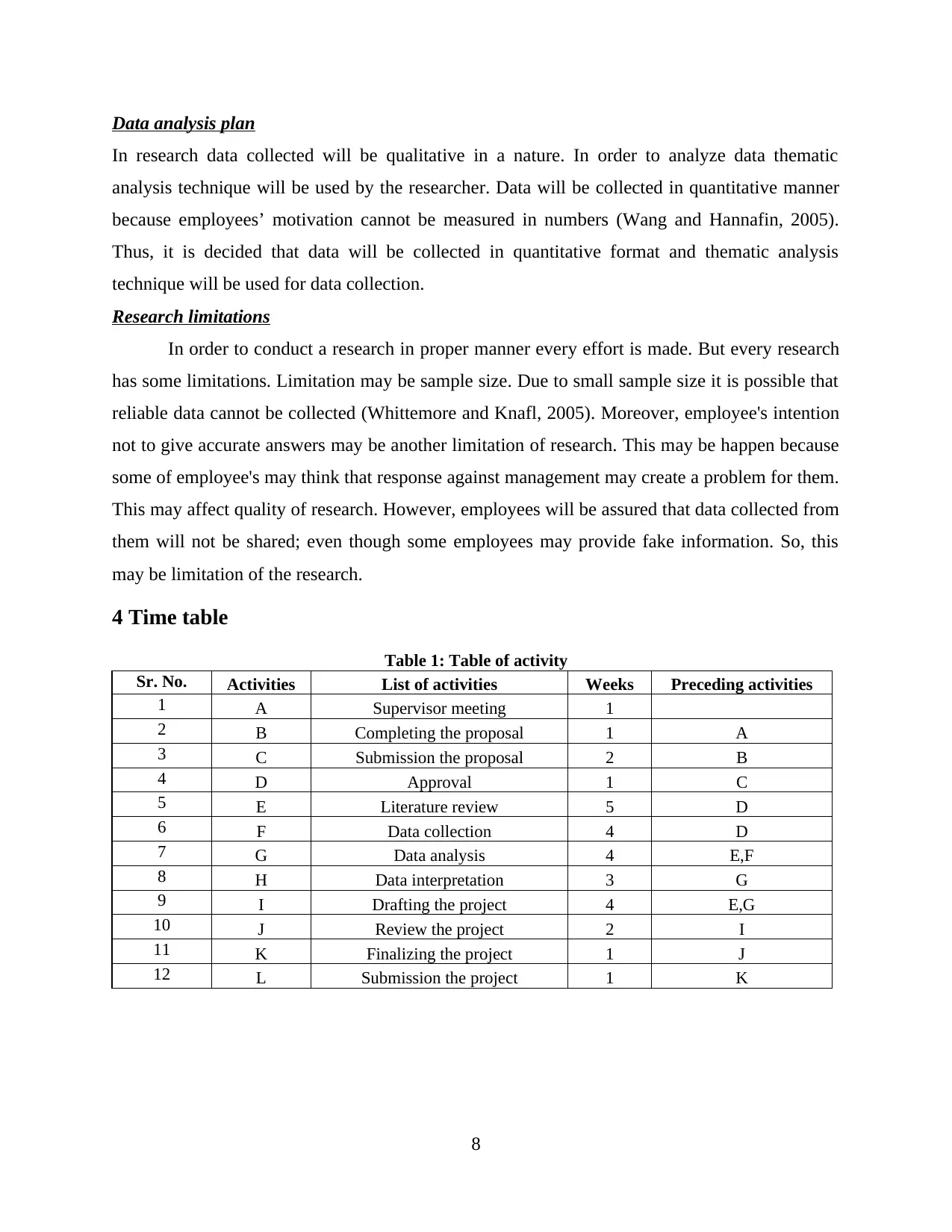
Data analysis plan
In research data collected will be qualitative in a nature. In order to analyze data thematic
analysis technique will be used by the researcher. Data will be collected in quantitative manner
because employees’ motivation cannot be measured in numbers (Wang and Hannafin, 2005).
Thus, it is decided that data will be collected in quantitative format and thematic analysis
technique will be used for data collection.
Research limitations
In order to conduct a research in proper manner every effort is made. But every research
has some limitations. Limitation may be sample size. Due to small sample size it is possible that
reliable data cannot be collected (Whittemore and Knafl, 2005). Moreover, employee's intention
not to give accurate answers may be another limitation of research. This may be happen because
some of employee's may think that response against management may create a problem for them.
This may affect quality of research. However, employees will be assured that data collected from
them will not be shared; even though some employees may provide fake information. So, this
may be limitation of the research.
4 Time table
Table 1: Table of activity
Sr. No. Activities List of activities Weeks Preceding activities
1 A Supervisor meeting 1
2 B Completing the proposal 1 A
3 C Submission the proposal 2 B
4 D Approval 1 C
5 E Literature review 5 D
6 F Data collection 4 D
7 G Data analysis 4 E,F
8 H Data interpretation 3 G
9 I Drafting the project 4 E,G
10 J Review the project 2 I
11 K Finalizing the project 1 J
12 L Submission the project 1 K
8
In research data collected will be qualitative in a nature. In order to analyze data thematic
analysis technique will be used by the researcher. Data will be collected in quantitative manner
because employees’ motivation cannot be measured in numbers (Wang and Hannafin, 2005).
Thus, it is decided that data will be collected in quantitative format and thematic analysis
technique will be used for data collection.
Research limitations
In order to conduct a research in proper manner every effort is made. But every research
has some limitations. Limitation may be sample size. Due to small sample size it is possible that
reliable data cannot be collected (Whittemore and Knafl, 2005). Moreover, employee's intention
not to give accurate answers may be another limitation of research. This may be happen because
some of employee's may think that response against management may create a problem for them.
This may affect quality of research. However, employees will be assured that data collected from
them will not be shared; even though some employees may provide fake information. So, this
may be limitation of the research.
4 Time table
Table 1: Table of activity
Sr. No. Activities List of activities Weeks Preceding activities
1 A Supervisor meeting 1
2 B Completing the proposal 1 A
3 C Submission the proposal 2 B
4 D Approval 1 C
5 E Literature review 5 D
6 F Data collection 4 D
7 G Data analysis 4 E,F
8 H Data interpretation 3 G
9 I Drafting the project 4 E,G
10 J Review the project 2 I
11 K Finalizing the project 1 J
12 L Submission the project 1 K
8
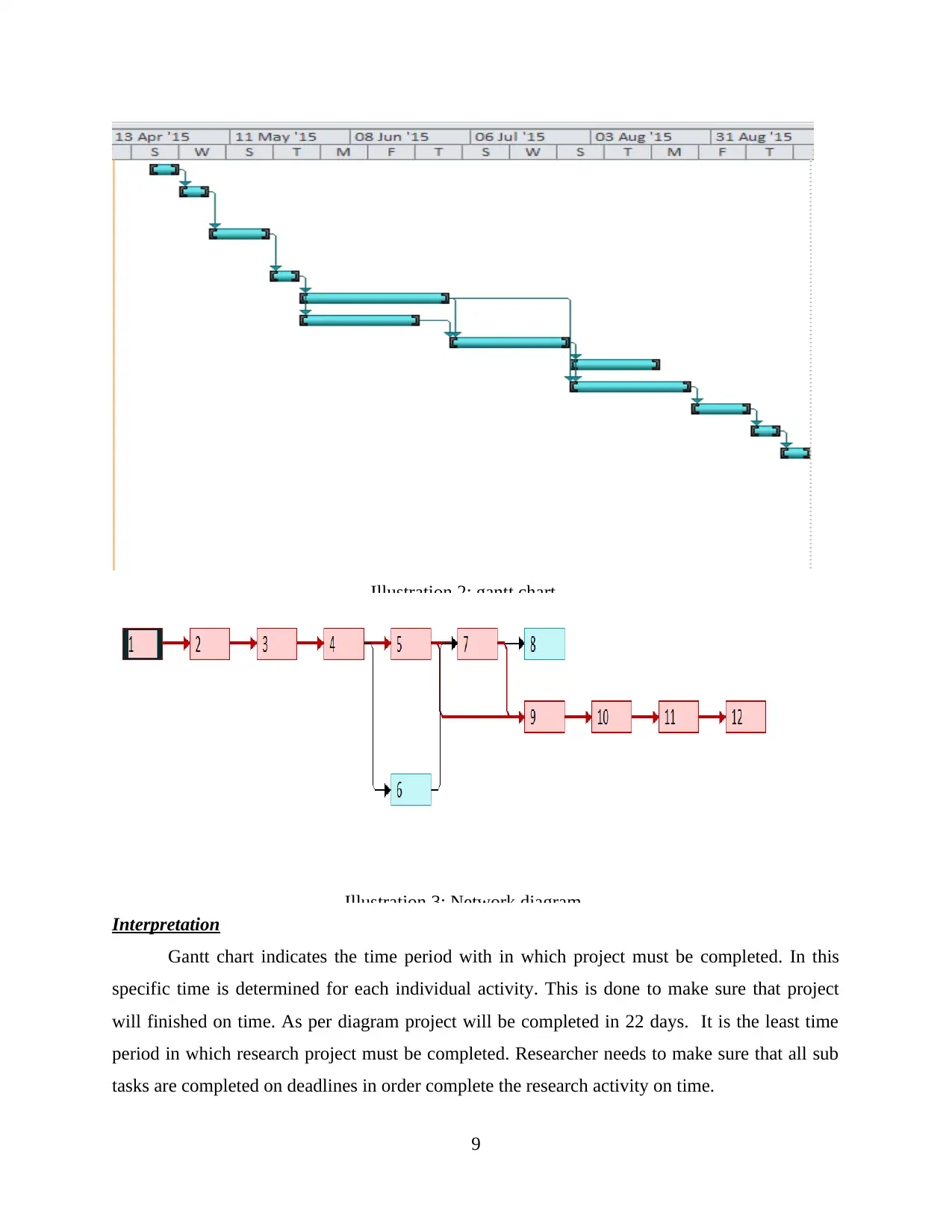
Illustration 2: gantt chart
Illustration 3: Network diagram
Interpretation
Gantt chart indicates the time period with in which project must be completed. In this
specific time is determined for each individual activity. This is done to make sure that project
will finished on time. As per diagram project will be completed in 22 days. It is the least time
period in which research project must be completed. Researcher needs to make sure that all sub
tasks are completed on deadlines in order complete the research activity on time.
9
Illustration 3: Network diagram
Interpretation
Gantt chart indicates the time period with in which project must be completed. In this
specific time is determined for each individual activity. This is done to make sure that project
will finished on time. As per diagram project will be completed in 22 days. It is the least time
period in which research project must be completed. Researcher needs to make sure that all sub
tasks are completed on deadlines in order complete the research activity on time.
9
Secure Best Marks with AI Grader
Need help grading? Try our AI Grader for instant feedback on your assignments.
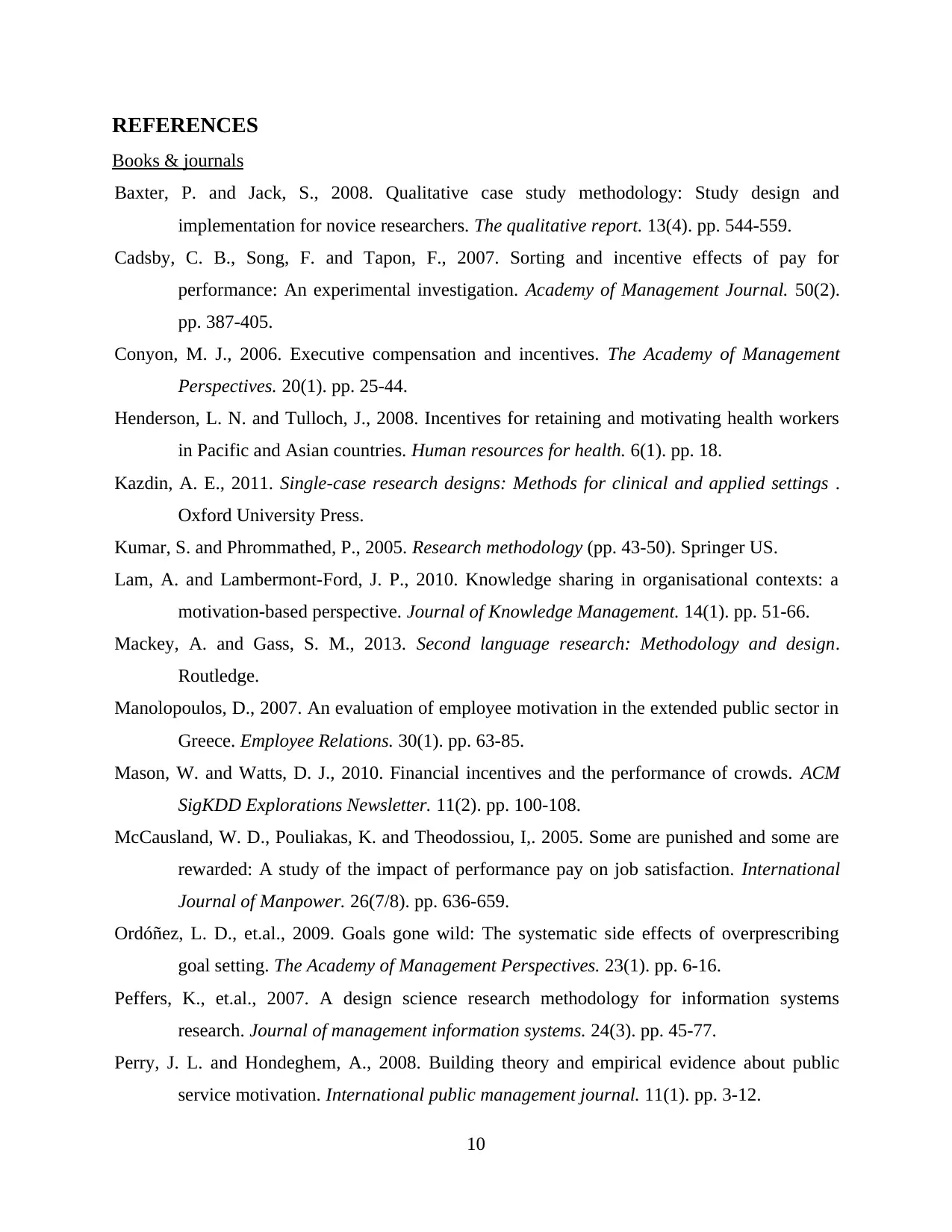
REFERENCES
Books & journals
Baxter, P. and Jack, S., 2008. Qualitative case study methodology: Study design and
implementation for novice researchers. The qualitative report. 13(4). pp. 544-559.
Cadsby, C. B., Song, F. and Tapon, F., 2007. Sorting and incentive effects of pay for
performance: An experimental investigation. Academy of Management Journal. 50(2).
pp. 387-405.
Conyon, M. J., 2006. Executive compensation and incentives. The Academy of Management
Perspectives. 20(1). pp. 25-44.
Henderson, L. N. and Tulloch, J., 2008. Incentives for retaining and motivating health workers
in Pacific and Asian countries. Human resources for health. 6(1). pp. 18.
Kazdin, A. E., 2011. Single-case research designs: Methods for clinical and applied settings .
Oxford University Press.
Kumar, S. and Phrommathed, P., 2005. Research methodology (pp. 43-50). Springer US.
Lam, A. and Lambermont-Ford, J. P., 2010. Knowledge sharing in organisational contexts: a
motivation-based perspective. Journal of Knowledge Management. 14(1). pp. 51-66.
Mackey, A. and Gass, S. M., 2013. Second language research: Methodology and design.
Routledge.
Manolopoulos, D., 2007. An evaluation of employee motivation in the extended public sector in
Greece. Employee Relations. 30(1). pp. 63-85.
Mason, W. and Watts, D. J., 2010. Financial incentives and the performance of crowds. ACM
SigKDD Explorations Newsletter. 11(2). pp. 100-108.
McCausland, W. D., Pouliakas, K. and Theodossiou, I,. 2005. Some are punished and some are
rewarded: A study of the impact of performance pay on job satisfaction. International
Journal of Manpower. 26(7/8). pp. 636-659.
Ordóñez, L. D., et.al., 2009. Goals gone wild: The systematic side effects of overprescribing
goal setting. The Academy of Management Perspectives. 23(1). pp. 6-16.
Peffers, K., et.al., 2007. A design science research methodology for information systems
research. Journal of management information systems. 24(3). pp. 45-77.
Perry, J. L. and Hondeghem, A., 2008. Building theory and empirical evidence about public
service motivation. International public management journal. 11(1). pp. 3-12.
10
Books & journals
Baxter, P. and Jack, S., 2008. Qualitative case study methodology: Study design and
implementation for novice researchers. The qualitative report. 13(4). pp. 544-559.
Cadsby, C. B., Song, F. and Tapon, F., 2007. Sorting and incentive effects of pay for
performance: An experimental investigation. Academy of Management Journal. 50(2).
pp. 387-405.
Conyon, M. J., 2006. Executive compensation and incentives. The Academy of Management
Perspectives. 20(1). pp. 25-44.
Henderson, L. N. and Tulloch, J., 2008. Incentives for retaining and motivating health workers
in Pacific and Asian countries. Human resources for health. 6(1). pp. 18.
Kazdin, A. E., 2011. Single-case research designs: Methods for clinical and applied settings .
Oxford University Press.
Kumar, S. and Phrommathed, P., 2005. Research methodology (pp. 43-50). Springer US.
Lam, A. and Lambermont-Ford, J. P., 2010. Knowledge sharing in organisational contexts: a
motivation-based perspective. Journal of Knowledge Management. 14(1). pp. 51-66.
Mackey, A. and Gass, S. M., 2013. Second language research: Methodology and design.
Routledge.
Manolopoulos, D., 2007. An evaluation of employee motivation in the extended public sector in
Greece. Employee Relations. 30(1). pp. 63-85.
Mason, W. and Watts, D. J., 2010. Financial incentives and the performance of crowds. ACM
SigKDD Explorations Newsletter. 11(2). pp. 100-108.
McCausland, W. D., Pouliakas, K. and Theodossiou, I,. 2005. Some are punished and some are
rewarded: A study of the impact of performance pay on job satisfaction. International
Journal of Manpower. 26(7/8). pp. 636-659.
Ordóñez, L. D., et.al., 2009. Goals gone wild: The systematic side effects of overprescribing
goal setting. The Academy of Management Perspectives. 23(1). pp. 6-16.
Peffers, K., et.al., 2007. A design science research methodology for information systems
research. Journal of management information systems. 24(3). pp. 45-77.
Perry, J. L. and Hondeghem, A., 2008. Building theory and empirical evidence about public
service motivation. International public management journal. 11(1). pp. 3-12.
10
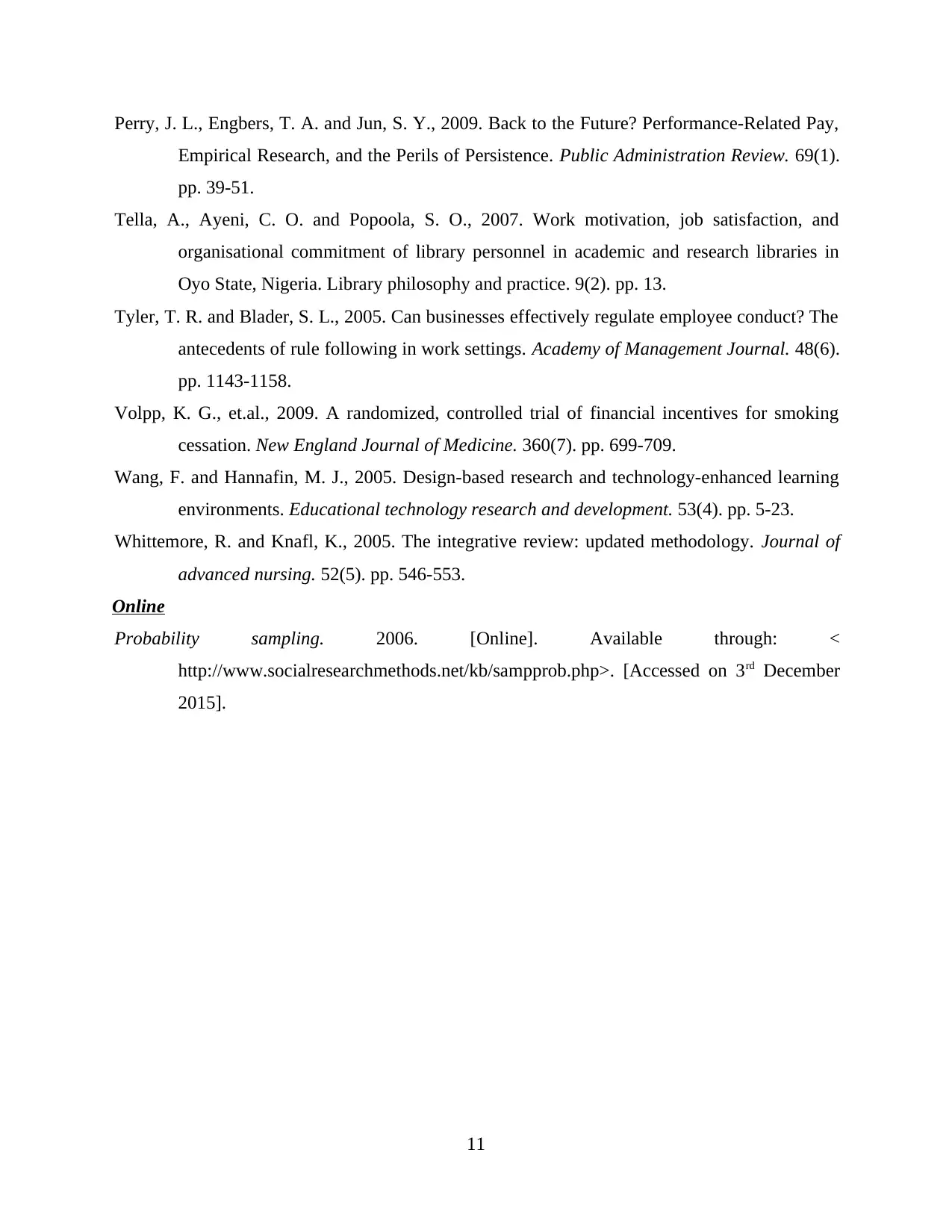
Perry, J. L., Engbers, T. A. and Jun, S. Y., 2009. Back to the Future? Performance‐Related Pay,
Empirical Research, and the Perils of Persistence. Public Administration Review. 69(1).
pp. 39-51.
Tella, A., Ayeni, C. O. and Popoola, S. O., 2007. Work motivation, job satisfaction, and
organisational commitment of library personnel in academic and research libraries in
Oyo State, Nigeria. Library philosophy and practice. 9(2). pp. 13.
Tyler, T. R. and Blader, S. L., 2005. Can businesses effectively regulate employee conduct? The
antecedents of rule following in work settings. Academy of Management Journal. 48(6).
pp. 1143-1158.
Volpp, K. G., et.al., 2009. A randomized, controlled trial of financial incentives for smoking
cessation. New England Journal of Medicine. 360(7). pp. 699-709.
Wang, F. and Hannafin, M. J., 2005. Design-based research and technology-enhanced learning
environments. Educational technology research and development. 53(4). pp. 5-23.
Whittemore, R. and Knafl, K., 2005. The integrative review: updated methodology. Journal of
advanced nursing. 52(5). pp. 546-553.
Online
Probability sampling. 2006. [Online]. Available through: <
http://www.socialresearchmethods.net/kb/sampprob.php>. [Accessed on 3rd December
2015].
11
Empirical Research, and the Perils of Persistence. Public Administration Review. 69(1).
pp. 39-51.
Tella, A., Ayeni, C. O. and Popoola, S. O., 2007. Work motivation, job satisfaction, and
organisational commitment of library personnel in academic and research libraries in
Oyo State, Nigeria. Library philosophy and practice. 9(2). pp. 13.
Tyler, T. R. and Blader, S. L., 2005. Can businesses effectively regulate employee conduct? The
antecedents of rule following in work settings. Academy of Management Journal. 48(6).
pp. 1143-1158.
Volpp, K. G., et.al., 2009. A randomized, controlled trial of financial incentives for smoking
cessation. New England Journal of Medicine. 360(7). pp. 699-709.
Wang, F. and Hannafin, M. J., 2005. Design-based research and technology-enhanced learning
environments. Educational technology research and development. 53(4). pp. 5-23.
Whittemore, R. and Knafl, K., 2005. The integrative review: updated methodology. Journal of
advanced nursing. 52(5). pp. 546-553.
Online
Probability sampling. 2006. [Online]. Available through: <
http://www.socialresearchmethods.net/kb/sampprob.php>. [Accessed on 3rd December
2015].
11
1 out of 12
Related Documents
Your All-in-One AI-Powered Toolkit for Academic Success.
+13062052269
info@desklib.com
Available 24*7 on WhatsApp / Email
![[object Object]](/_next/static/media/star-bottom.7253800d.svg)
Unlock your academic potential
© 2024 | Zucol Services PVT LTD | All rights reserved.





